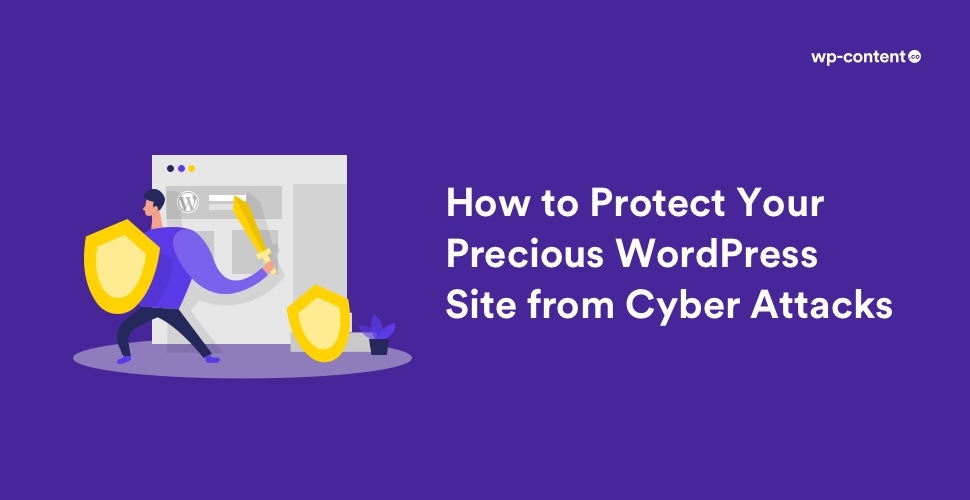Protecting your WordPress website from cyber attacks is definitely one of the things that will constantly be on your mind if you own a site. Creating a good website is easy compared to maintaining it and protecting it from hackers and others with evil intent.
Many complain about the security of WordPress. But the core software of WordPress is very secure and is audited regularly by hundreds of developers making it more secure than other platforms existing today. But that does not mean that you can afford to be complacent when it comes to protecting your site. We will discuss some security tips and strategies you can follow to protect your website.
1. Select a reliable hosting provider
If you value the security of your website, you will work only with reliable, safe and high-quality hosting providers because a good portion of hacking attempts come through security vulnerabilities of the hosting server. A good host should be able to secure your website from most malware, adware, spyware, trojans and other malicious entities. You can choose any hosting type like shared hosting or managed hosting depending on your website traffic and budget. We have already shared with you a list of budget-friendly hosting providers as well as a list of specialized managed WordPress hosting providers.
Also read: Shared v/s VPS v/s Managed WordPress hosting
2. Strengthen your passwords
Strengthening your passwords is one of the easiest ways of securing your website. Your passwords should be strong and difficult to guess. You can add more words to make the passwords longer and better thus reducing the chances of brute force attacks. You can also use password generators like 1Password or LastPass to get secure passwords and store them sparing you the trouble of having to remember them. Please avoid childish and simple ones like 12345.

3. Secure the wp-config.php file
The wp-config.php file is the most important file in your site’s root directory. It has crucial information regarding WordPress installation including username, password database name, and other information that can access the data and database. Making the wp-config.php file safe from attackers is thus crucial to protecting your WordPress website. You can take it beyond the grasp of hackers by simply moving it to a level higher than your root directory.
Also read: A Guide to WordPress Website Maintenance
4. Disable File Editing
The built-in file editor makes your life easier by allowing you to edit the theme and plugin files from the WordPress admin area. But if this feature happens to fall into the wrong hands, you can only imagine the havoc it will result in. So to prevent such situations where someone can edit your files, it is better to turn this feature offend reduce the risk of cyber attacks. You can disable the file editing option by adding the following to the wp-config. php file:
define(‘DISALLOW_FILE_EDIT’, true);
5. Disable directory browsing
Directory browsing can help you access the site’s structure and individual directories very quickly. But the same can also assist hackers in finding vulnerable files, themes, and plugins to plunder your site. If you are partnered with a good hosting provider, they will take care of this but if you are self-hosting your site, it is better to disable directory browsing. Connect to your website using FTP or cPanel’s file manager to locate the .htaccess file in the root directory and add the line Options -Indexes at the end of the .htaccess file. Then save and upload the file back to your site.
6. Change Directory Permissions
If you are using shared hosting, wrong directory permissions can land you in real trouble. So to reduce the risk of cyber attacks, secure the website at the hosting level. Changing the directory permissions to “755” and that of files to “644” can protect the whole file system. You can do it manually via the File Manager inside your hosting control panel or through the terminal using the “chmod” command.
7. Update WordPress
WordPress is an open-source software that releases updates frequently to keep up with the security challenges. WordPress automatically installs minor updates but major updates have to be done manually. You can know about the updates through email notifications or from your dashboard. Also, remember to keep your plugins and themes too updated to protect your website from cyber attacks.
8. Change WordPress Database Prefix
WordPress uses wp_ as the default prefix in the database. If you are using this default database prefix, you are practically welcoming the SQL injection attacks and other digital problems because it allows hackers to guess the table names easily and attack your database. You can minimize this risk by simply changing the prefix to a unique term like ‘newwp_’, ‘websitewp_’ etc.
9. Add a Secure Socket Layer (SSL)
SSL is a protocol that encrypts the data transfer between your website and the user’s browser. It ensures data security and protection from hackers besides increasing the site’s SEO ranking and trustworthiness. Getting an SSL certificate is easy – most of the hosting companies provide it for free or you can purchase it from a dedicated company. Installing it is also very simple.
10. Maintain regular backups
Backups allow you to restore your site to its previous condition in case something goes wrong. Today most of the hosting providers offer this service in their packages. But to be on the safe side, it is better if you can maintain additional backups. There are many free and paid backup plugins too that you can use. Backups can save you from building your website from scratch and gives you peace of mind. You can remote store the backups to cloud or local storage depending on your preference.
Also read: Top WordPress Backup Solutions
Protecting your WordPress website from cyber-attacks becomes all the more important and challenging because hackers are becoming more and more innovative and finding out new ways to endanger the sites. By following the simple ten steps above, you can mitigate their effects to some extent and create a layer of protection around your site. But remember protecting your site is not a one-time business but rather an ongoing one. Be on your toes to rescue your website at the first sight of trouble!



